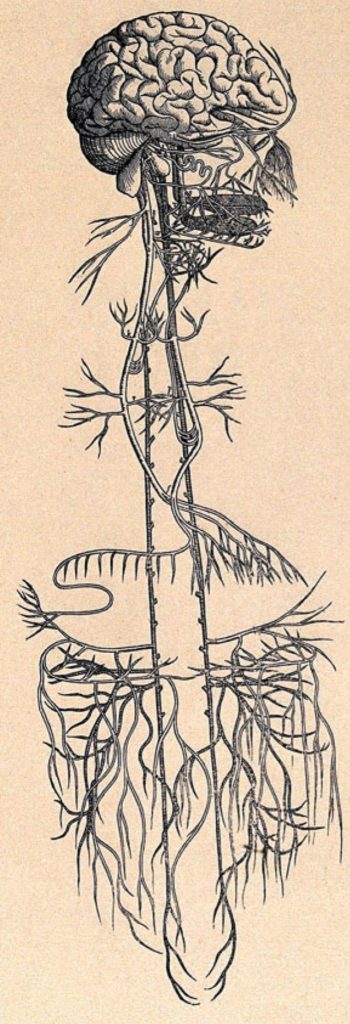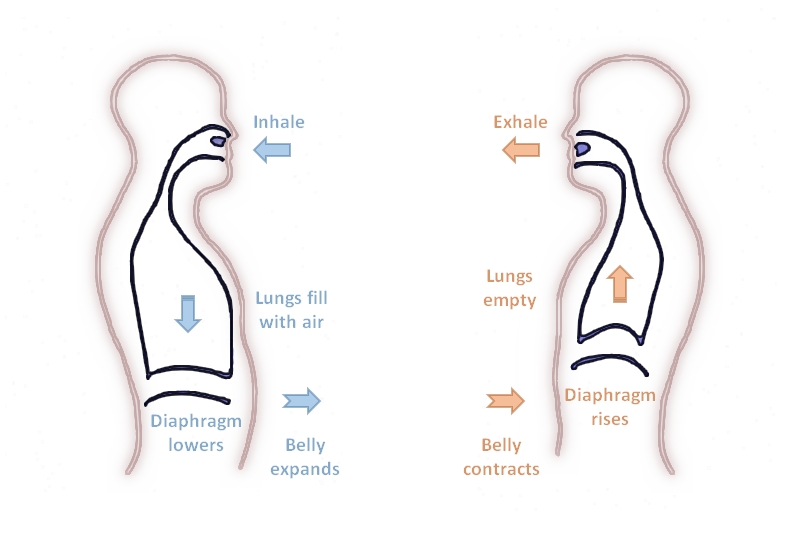Feel Calm And Resilient By Strengthening Your Vagus Nerve
Recipe Key
We don’t have control over what’s going on in the world but we can control how we respond to it. Good vagal tone helps us find relief and allows us to choose better feeling thoughts no matter what occurs.

Lately, a lot of people are wondering how to stay calm and feel good when there is so much uncertainty, fear and chaos in the world right now. It is challenging and I’m here today to explain how strengthening our vagus nerve helps us move more easily from feeling anxious to relaxed. We become more resilient.
What Is the Vagus Nerve?
The vagus nerve is the longest nerve in your body. It runs from your brain down into the lowest part of your intestines and touches most major organs along the way, including your heart, lungs and digestive system.
The vagus nerve is part of the autonomic nervous system that operates without you even thinking about it.
Low vagal tone indicates stress and is characterized by anxiety, negativity, weak digestion, depression, and inflammation.
Good vagus nerve function is instrumental in keeping us calm and centered. It activates the “relaxation response” of the parasympathetic nervous system, which in turn, decreases anxiety, stress, and inflammation.
I became interested in the vagus nerve when I heard microbiologist Kran Krishnan explain how important it is for moving food and waste through your digestive system,(peristalsis) He said a toned vagus nerve relieves constipation, something I’ve been dealing with my whole life. But that is only a small part of what your vagus nerve does.
Research shows that a strong vagal tone (flowing vagus nerve activity) makes your body better at digestion and regulating blood glucose levels allowing your body to get the right nutrients into your cells.
A well-functioning vagus nerve sends signals to the immune system to shut down inflammation.
Strengthening your vagal tone can help relieve brain fog, fatigue, anxiety, and depression.
The vagus nerve is also involved in swallowing and producing sound vibrations including speech.
How Good Vagal Tone Helps Keep You Calm
You’ve probably heard about the Gut-Brain connection but that’s only half the story. A “connection” implies a response, so there is also a “Brain-Gut connection”. There is conversation occurring between the intestinal microbiome and the brain happening through the vagus nerve.
It’s an actual conversation. The communications between the intestinal microbiome and the brain and the brain back to the intestinal microbiota are “bi- directional”. The vagus nerve sends signals in both directions. 80% flows from the body to the brain and 20% goes from the brain to the body.
When you have low vagal tone it’s like the brain is putting its fingers in its ears saying really loud “la, la, la I can’t hear you” and the communication breaks down.
Since your gut produces the majority of the serotonin in your body and the vagus nerve transmits the mood-boosting serotonin to your brain, when the vagus nerve isn’t working well the serotonin can’t get to your brain and you feel anxious, afraid or even depressed.
Another way the vagus nerve keeps you calm is every time you EXHALE, your vagus nerve squirts “vagusstoff” or “vagus substance” onto your heart. Vagusstoff acts as a tranquilizer-like substance to slow down beat-to-beat intervals and improves heart rate variability (HRV).
People with higher HRV can move more easily from anxiety to relaxed and can recover more easily from stress.
9 Ways to Strengthening Your Vagal Tone
We can support our vagus nerve to help you stay calm even though we are living in stressful times. Stimulating the vagus nerve reduces the cortisol-producing stress response of fight-or-flight and increases oxytocin (cuddle hormone) and serotonin (happiness hormone) .
Here are a few practical ways to strengthen your vagal tone and improve the Gut-Brain connection and communication.
1. Belly Breathing
Deep breathing, also called diaphragmatic breathing, resets the vagus nerve. Extending the length of the exhale counterbalances any over-stimulation of the sympathetic nervous system.
This type of breathing stimulates the vagus nerve so all of the parts of your body it regulates are instantly calmed.
The vagus nerve is listening to the way we breathe, and it sends the brain and the heart whatever message our breath indicates.

How to Do Belly Breathing
- Stand, sit or lie down comfortably with your shoulders, head and neck relaxed. If you’re sitting or lying down have your knees bent.
- Place one hand on your upper chest and the other just below your rib cage. This will allow you to feel your diaphragm move as you breathe.
- Breath in for a count of 6. Breathe in slowly through your nose so that your stomach moves out against your hand. It should feel like your stomach is filling up like a ball. The hand on your chest should remain as still as possible.
- Hold your breath for a count of 4.
- Breathe out for a count of 8. (longer than the in-breath). Tighten your stomach muscles, letting them fall inward as the ball deflates as you exhale through pursed lips. Keep the hand on your upper chest as still as possible.
- Hold the out breath for a count of 4.
- Start with 4 rounds and work up to 10.
Note: If you find it hard to do the belly breathing for 6 counts do less. Breathe in for 4, hold for 2, breath out for 6, hold for 2. If the count is too easy, then extend it, breath in for 8, hold for 6, breath out for 10, hold for 6. Be sure the out-breath is longer than the in-breath.
2. Chanting

Chanting is my favorite way to tone my vagus nerve. The vagus nerve is connected to your vocal cords and the muscles at the back of your throat. Chanting has been shown to increase heart-rate variability and vagal tone. Chanting gives you the added benefits of meditation which also strengthens your vagus nerve..
Practice: Chant the mantra in a steady rhythm with your eyes closed for 5-15 minutes. Keep your attention on your voice and breath as you chant. If your mind wanders gently bring it back to your voice chanting the mantra.
Here are 2 of my favorite chants: Aad Nuray Nameh and Saraswati
Aad Guray Nameh is a very powerful mantra used to gain clarity, and to receive guidance from one’s highest Self. This mantra creates a field of energy around you, attracting abundance and helping you live with a feeling of well-being.
Through chanting our feet can walk in happiness, and our mind can let go knowing all is well and we are supported by the Universe. Things are always working out for us.
3. Singing & Humming

Singing is much like chanting without the meditation. Since the vagus nerve is connected to the vocal cords, singing or humming mechanically stimulates it.
Choose a song to sing. Make it happy and fun. Belt it out loudly, with all the feeling you can muster, 3-5 minutes, once or twice a day. Do it in the shower or while driving in your car.
I like the songs Whistle A Happy Tune, A Little Help From My Friends (Beatles). Choose something positive as it may get stuck in your head for a while.
4. Meditation
Meditation is my favorite relaxation technique and it can stimulate the vagus nerve and increase vagal tone. Research shows that meditation increases vagal tone and positive emotions.
Meditation reduces sympathetic “fight or flight” activity and increases vagal modulation A Carnegie Mellon University (CMU) study identified how meditation improves levels of brain connectivity and lowered inflammation and stress indicating healthy vagal tone. For an assortment of meditations click Meditation Increases Health and Happiness
5. Cold Thermogenesis
Exposing your body briefly to cold conditions, such taking a cold shower or ending your shower with cold water increases stimulation of the vagus nerve. While your body adjusts to the cold, sympathetic activity declines, while parasympathetic activity increases. If you’re like me and find cold showers too severe, splashing your face 10 times with cold water will be beneficial.
6. Gargling

This method has been researched for over 30 years via the Carrick Institute; it’s a tried-and-true method. Like singing loudly in the car or shower this one is easy to do in the shower or at the bathroom sink. A strong and enthusiastic gargling episode sends signals directly to the vagus nerve via the gargle muscles with a message, albeit garbled, that is interpreted as a wake-up call of re-engagement of the brain/nerve function. Some people will experience tearing of the eyes during this process, which is nothing to worry about.
How to do it. Take a full glass of pure water and gargle your way through each sip. It’s fine to swallow the water or spit it out. Gargle with enthusiasm and push your limits. This technique only works when you gargle longer than you are used to.
7. Compassion and Connection
Feeling connected and empathizing with others stimulates the vagus nerve. Scientists have found that experiencing compassion activates the parasympathetic nervous system and increases vagal tone.(2)
The vagus is activated through social engagement. Connecting with people, socialize and laugh, and enjoy life as much as possible improves your vagal tone.
Self-compassion — extending warmth and understanding to yourself and speaking to yourself kindly also counteracts the stress response of the sympathetic nervous system. The next time you find yourself comforting a friend or relating to a suffering stranger in a news story, know that you’re strengthening your vagus nerve, leading to calmer vibes ahead.
8. Healthy Gut Microbiome
The presence of healthy bacteria in the gut creates a positive feedback loop through the vagus nerve, increasing its tone. Good gut bacteria is achieved with a diet of whole foods and probiotic foods. Read more about maintaining a healthy microbiome in my articles:
Healthy Eating Tips
Fiber is One of the Most Magical Nutrients You Can Eat
Feed Your Good Gut Bacteria with Prebiotics.
9. Massage
Consider getting a regular massage or perform self-massage, to enhance the vagal activity and improve vagal tone. Things like foot reflexology are a great way to stimulate the vagus nerve.
In conclusion: Low vagal tone indicates stress and is characterized by anxiety, negativity, weak digestion, depression, and inflammation. Optimal vagal tone is illustrated by one’s ability to manage stress, to soothe yourself and return to a state of well-being.
When you have good vagal tone, you’re more resilient. Deepak Chopra says “The more flexible you are, the more adaptable you are. You must stimulate the vagus nerve to do this.” which is why I hope this article inspires to do a few easy processes to strengthen and tone your vagus nerve.

Thank you Ingrid this was timely as my yoga teacher was talking about this yesterday and had us doing voice exercises.
Fantastic I love synchronicities. It’s the Universe playing with us. I was also inspired by my article and chanted this morning. It felt so good. Thanks for sharing. Much love.